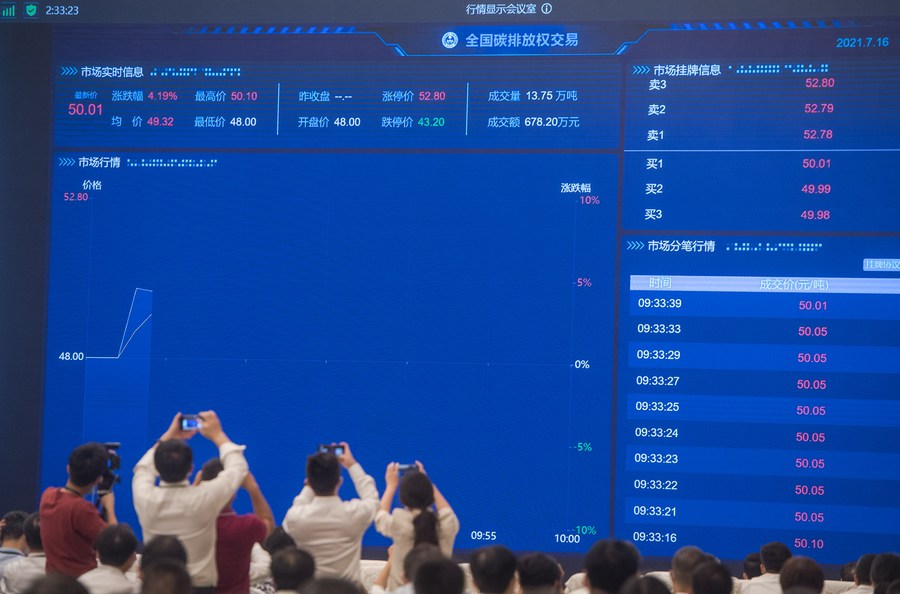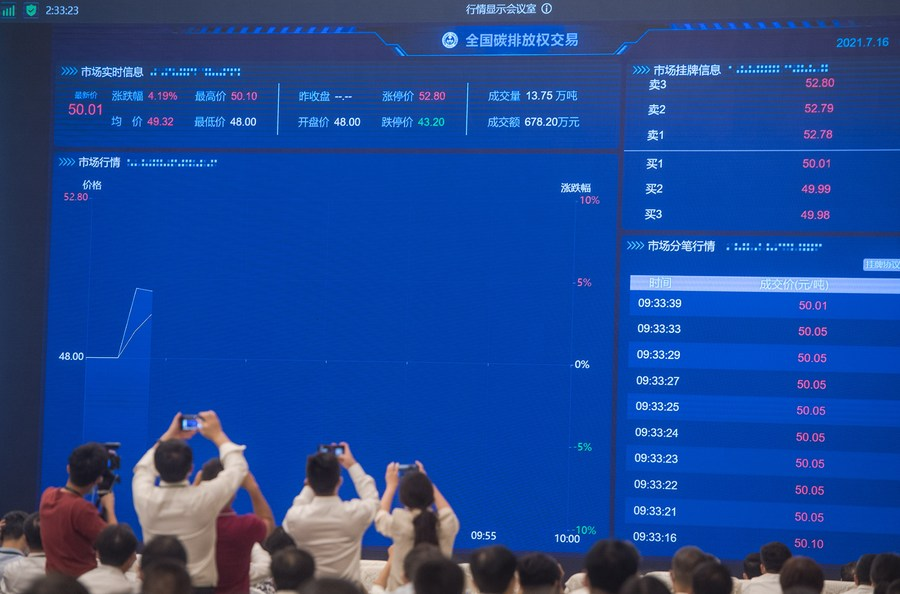
Photo taken on July 16, 2021 shows a screen displaying real-time information of national carbon emission trading in Wuhan, central China's Hubei Province. (Xinhua/Xiao Yijiu)
BEIJING, July 21 (Xinhua) -- The emerging role of China's national carbon emissions trading market in promoting enterprises' emission reduction and carbon pricing has attracted widespread attention and gained proper recognition both at home and abroad with the unveiling of the first-year "report card" of the national carbon market.
China's national carbon market has reported a total trading volume of 194 million tonnes and a turnover of nearly 8.5 billion yuan.
According to industry insiders, the pressing task at present is to increase the activity of the national carbon emissions trading market, study and formulate a roadmap for the development of the national carbon market, and work for the resumption of the China Certified Emissions Reductions (CCER) mechanism.
-- Carbon price has potential to go up further
Lai Xiaoming, chairman of the Shanghai Environment and Energy Exchange (SEEE), said that since its launch one year ago, the national carbon market has played an important role in controlling and reducing greenhouse gas emissions, boosting green and low-carbon development, and promoting the realization of the goals of carbon peaking and carbon neutrality. Over the past year, the market has been running smoothly, effectively serving enterprises' efforts to reduce emissions and promoting the formation of carbon pricing.
According to reports, since its launch on July 16, 2021, the national carbon market has included 2,162 key power-generating enterprises and covered about 4.5 billion tonnes of carbon dioxide emissions, making it the world's largest carbon market.
The national carbon market wrapped up its first compliance period on December 31, 2021, with the compliance rate reaching 99.5 percent.
The market recorded a total trading volume of carbon emission quotas of 179 million tonnes and a turnover of 7.661 billion yuan, with the average transaction price standing at 42.85 yuan per tonne. As of July 15, 2022, the national carbon market has seen the total trading volume of quotas reach 194 million tonnes and the turnover near 8.5 billion yuan.
The carbon price opened at 48 yuan per tonne. On July 15 this year, the carbon price closed at 58.24 yuan per tonne, up by 21.33 percent compared with the opening price on the first trading day.
Since the beginning of this year, the market has been running in a sound and orderly manner, and the trading price has risen steadily, with the closing price fluctuating between 56 yuan per tonne to 62 yuan per tonne.
According to Richard L. Sandor, the founder of the Chicago Climate Exchange and the American Financial Exchange, China's carbon market has witnessed sound development, with statistics showing that it fared much better than expected. He believes that China will definitely show the same attractiveness in the next two or three years.
"Overall, the national carbon price has the potential to go up further, but its increase will be limited by market activity. It is expected that the carbon price will fluctuate between 55 yuan per tonne to 65 yuan per tonne," said a relevant person at SinoCarbon Innovation & Investment Co., Ltd.
Zhang Xiliang, director of the Institute of Energy, Environment and Economy with Tsinghua University, said calculations show that to achieve the target of carbon emission reduction during the 13th Five-Year Plan period, the carbon price was at about 58 yuan, and it will rise to about 68 yuan during the 14th Five-Year Plan period, about 104 yuan during the 15th Five-Year Plan period, and 178 yuan during the 16th Five-Year Plan period. As more stringent requirements for emission reduction in the future will lead to fewer opportunities for low-cost emission reduction, the carbon price is on a rising trend.
-- Number of key emitters to top 8,000
According to the SEEE, since the launch of the national carbon market, there have been transactions on every trading day, and the trading volume fluctuated significantly in line with the compliance period.
Since the opening of the market, the cumulative number of enterprises participating in the trading has exceeded more than half of the total number of key emitters. The highest number of enterprises participating in the trading in a single day stood at 179, and a total of 18 provinces have seen more than 50 percent of key emitters engaging in the trading.
To enhance the influence of China's carbon market in the world, the key is to introduce investment institutions, including world-class carbon asset management institutions, and introduce more market players, including some multinational manufacturing companies, said Qi Kang, deputy general manager of Shanghai Energy Conservation Center Co., Ltd.
At the 2022 China International Carbon Trading Conference held in Shanghai on July 16, Li Gao, director-general of the Climate Change Adaptation Department under the Ministry of Ecology and Environment, said that in the next stage, continued efforts will be made to strengthen the national laws, regulations and policy systems related to the carbon market, actively push for the issuance of interim regulations on the management of carbon emissions trading, and improve the supporting trading system and related technical specifications.
According to relevant plans, during the 14th Five-Year Plan period (2021-2025), China's national carbon market is expected to cover eight high energy-consuming industries, including the power generation industry, iron and steel, non-ferrous metals, petrochemicals, chemicals, construction materials, paper manufacturing, and aviation. The number of key emitters will be expanded from more than 2,000 in the power generation industry to 8,000-10,000 in the eight industries.
-- Development of public benefits from carbon emission reduction markets expected to speed up
To synergize the domestic and international carbon market, the SEEE also actively supported the development of the voluntary carbon markets and public benefits from carbon emission reduction markets, and promoted the interconnection with compliance carbon markets, so as to form a multi-level and composite carbon market structure.
SEEE actively incorporates the development of carbon markets and carbon finance into the international financial system of Shanghai, actively promotes carbon finance innovations such as carbon repurchase, carbon pledge, carbon index, carbon trust and carbon fund, and will launch carbon swaps, carbon forwards and other derivatives transactions in due course, so as to build Shanghai into a carbon market pricing center with international influence, said Lai.
An industrial insider noted that at present, the Ministry of Ecology and Environment is promoting the relaunch and development of the voluntary emission reduction system. The key is to improve the methodological system and establish a scientific and reliable data verification and reporting system. .
Xiong Yi, senior vice president for strategy and business development at Schneider Electric China, said that sustainable development is an ecology that requires the joint efforts of the government, enterprises, industry associations and other parties.
He also pointed out that at present, the pressing task is to achieve the "dual carbon" goals. More companies need to clearly calculate the carbon footprint of the whole life cycle from a practical point of view and in a scientific and quantitative way.
Xiong recommended that companies should make relevant plans, actively participate in the carbon market and take solid steps to achieve the goals of carbon reduction and carbon neutrality. (Edited by Yang Yifan with Xinhua Silk Road, yangyifan@xinhua.org)




 A single purchase
A single purchase









